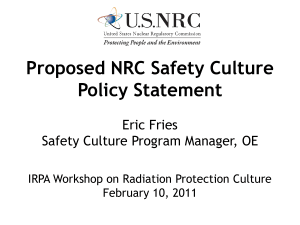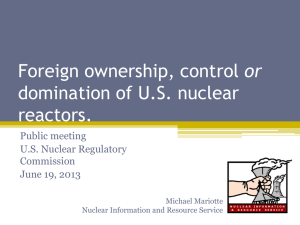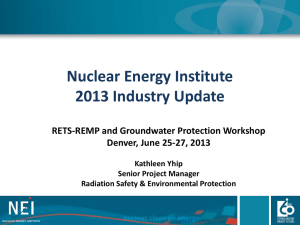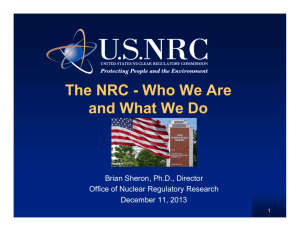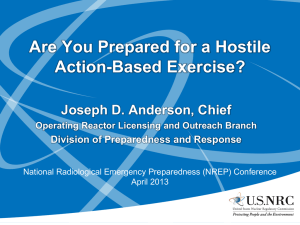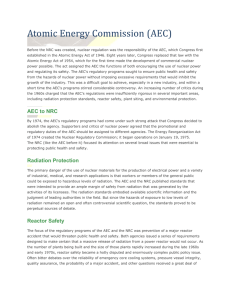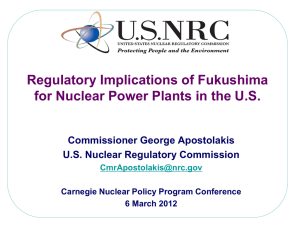Keefe- NRC Safety Culture
advertisement
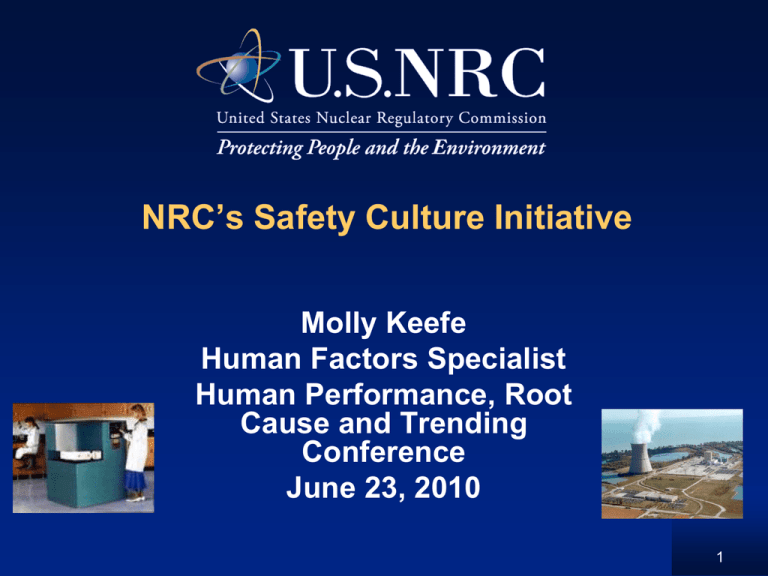
NRC’s Safety Culture Initiative Molly Keefe Human Factors Specialist Human Performance, Root Cause and Trending Conference June 23, 2010 1 Overview • Why safety culture is important to the NRC and to the those engaged in activities involving nuclear materials. – Historical events – Nexus • What is a policy statement • NRC Safety Culture Policy Statement – Key messages – Commission Direction • Safety Culture workshop • Next steps 2 Why Safety Culture is Important to the NRC • Operating experience has demonstrated there is a nexus between Safety Culture (SC) and events at NRCregulated facilities. • Because of the connection between the safe and secure use of radioactive materials and events where there is a weak or non-existent SC, NRC has a responsibility to consider SC. 3 Safety Culture Implementation • Reactor Oversight Process (ROP) Implemented in 2000 – 3 cross-cutting areas have safety culture ties: – SCWE – Problem identification and resolution (PI&R) – Human Performance Historical Events Involving Weak Safety Culture • 1986: Chernobyl accident in Russia • 1989 and 2007: Peach Bottom Atomic Power Station involving worker inattentiveness • 2002: Davis Bess involving a degraded pressure vessel head cavity • 2002 - 2008: Philadelphia VA Medical Center, involving 97 errors in the radiation treatment of prostate cancer 5 Other Industry Events • 2003 Columbia shuttle accident • 2006 BP oil refinery explosion in Texas City, TX • 2010 Gulf of Mexico oil spill 6 Policy Statement vs. Regulation • Policy statements may be issued to address – internal NRC programs or processes and – other matters relating to activities that are within NRC jurisdiction and of particular interest/importance to the Commission • Policy statements are not rules and are not accorded the status of a rule. • Policy statements are not binding upon, or enforceable against, NRC or Agreement State licensees. 7 1989 Policy Statement: Conduct of Operations • Safety Culture requires: – Necessary full attention to safety matters – Personal dedication and accountability of all individuals which has a bearing on the safety of nuclear power plants – Management has the duty and obligation to foster the development of a ‘safety culture’ at each facility and to provide a professional working environment, in the control room, and throughout the facility, that assures safe operations 1996: Policy Statement Freedom of Employees in the Nuclear Industry to Raise Safety Concerns without Fear of Retaliation. • Issued following retaliation for whistle-blowing issue at Millstone • Establish and maintain safety conscious work environment (SCWE) • Applied to all NRC-regulated activities of licensees, contractors, and applicants Commission Direction on Safety Culture Policy • February 2008 SRM – Expand policy statement to address security – Ensure applicability to all licensees • May 2009 SRM – Develop statement to include security – Expand to all licensees and certificate holders – Solicit feedback from stakeholders 10 Key Messages of the 2009 Draft Safety Culture Policy Statement - anyone performing or overseeing NRC-regulated activities - Proposes a definition and characteristics of a positive SC. - Safety and security are equally important in a positive SC. - Licensees and certificate holders are responsible for developing and maintaining a positive SC. - The NRC has an independent oversight role. 11 Commission Direction October 2009 SRM - Publish the policy statement in the Federal Register with a 90-day comment period). - Consider incorporating suppliers and vendors. - Continue to engage broad range of stakeholders. - Seek opportunities to comport terminology with existing standards and references. 12 Definition of Safety Culture in 2009 Draft Policy Statement • That assembly of characteristics, attitudes, and behaviors in organizations and individuals which establishes that as an overriding priority nuclear safety and security issues receive the attention warranted by their significance 13 Safety Culture Workshop – Large variety of stakeholders attended. – 16 stakeholders with various affiliations, with frequent attendee input, reached alignment on a SC definition and traits. • Workshop defined: Nuclear Safety Culture as “the core values and behaviors resulting from a collective commitment by leaders and individuals to emphasize safety over competing goals to ensure protection of people and the environment.” 14 NRC (Draft) SC Characteristics February 2-4, 2010, SC Workshop Traits Problem Identification and Evaluation The organization ensures that issues potentially impacting safety or security are promptly identified, fully evaluated, and promptly addressed and corrected commensurate with their significance. Problem Resolution and Metrics The organization ensures that issues potentially impacting safety or security are promptly identified, fully evaluated, and promptly addressed and corrected commensurate with their significance. Work Practices Personnel demonstrate ownership for nuclear safety and security in their day-to-day activities. Personal Responsibilities and Attitudes Everyone is personally responsible for nuclear safety. Work Planning and Control Process for planning and controlling work activities are implemented such that safety and security are maintained. Processes and Procedures Processes for planning and controlling work activities are implemented such that safety is maintained. Continuous Learning Environment The organization maintains a continuous learning environment in which opportunities to improve safety and security are sought out and implemented. Continuous Learning Organizational learning is embraced. Licensee Decision Making The organization’s decisions ensure that safety and security are maintained. Leadership Safety Behaviors Leaders demonstrate commitment to safety. Safety Conscious Work Environment The organization maintains a safety conscious work environment in which personnel feel free to raise safety and security concerns without fear of retaliation. Encouraging Report of Problems The organization maintains a safety conscious work environment in which personnel feel free to raise concerns without fear of retaliation. Accountability Roles, responsibilities, and authorities for safety and security are clearly defined and reinforced. Effective Safety Communication Effective communication is essential to maintain focus on safety. Resources The organization ensures that the personnel, equipment, tools, procedures, and other resources needed to ensure safety and security are available. Respectful Work Environment Trust and respect permeate the organization. 15 Schedule and Next Steps • Consider the public comments on the draft SC policy statement, results of the February workshop, and solicit comments through NRC’s safety culture website and stakeholder outreach activities • Propose a final safety culture policy statement for Commission approval (March 2011) • Evaluate whether modifications to NRC’s oversight programs are needed to implement the safety culture policy 16 Comments • NRC is interested in your views: – If you would like to submit comments on the SC definition and traits, please submit comments at the following website by November 24, 2010: http://www.nrc.gov/about-nrc/regulatory/enforcement/contactoe.html. – Please indicate which SC definition and traits you prefer and/or include potential comments to improve the SC definition and traits. 17 Comments? 18 Proposed Safety Culture Definitions • NRC: That assembly of characteristics, attitudes, and behaviors in organizations and individuals which establishes that as an overriding priority nuclear safety and security issues receive the attention warranted by their significance. • WORKSHOP: Nuclear Safety Culture is the core values and behaviors resulting from a collective commitment by leaders and individuals to emphasize safety over competing goals to ensure protection of people and the environment. 19 Proposed Workshop Traits Trait Description Problem Resolution and The organization ensures that issues potentially Metrics impacting safety or security are promptly identified, fully evaluated, and promptly addressed and corrected commensurate with their significance. Personal Responsibilities and Attitudes Everyone is personally responsible for nuclear safety. Processes and Procedures Processes for planning and controlling work activities are implemented such that safety is maintained. Continuous Learning Organizational learning is embraced. 20 Proposed Workshop Traits (continued) Trait Description Leadership Safety Behaviors Leaders demonstrate commitment to safety. Encouraging Report of Problems The organization maintains a safety conscious work environment in which personnel feel free to raise concerns without fear of retaliation. Effective Safety Communication Effective communication is essential to maintain focus on safety. Respectful Work Environment Trust and respect permeate the organization. 21 • The address for the webpage is: http://www.nrc.gov/aboutnrc/regulatory/enforcement/safetyculture.html 22 References • “Policy Statement on the Conduct of Nuclear Power Plant Operations,” 54 FR 3424, January 24, 1989. • “Freedom of Employees in the Nuclear Industry to Raise Safety Concerns Without Fear of Retaliation,” 61 FR 24336, May 14, 1996 • “Draft Safety Culture Policy Statement,” 74 FR 214, November 6, 2009 • NASA report: http://caib.nasa.gov/news/report/pdf/vol1/full/caib_report_volume1. pdf • Millstone Time Magazine article: http://www.time.com/time/magazine/article/0,9171,984206,00.html





